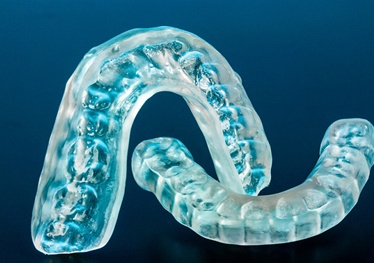
TMJ Treatment – Garland, TX
Protect Your Smile, Stop Jaw Discomfort
While you most likely consider your oral health to only focus on your teeth and gums, the mouth is made up of many complex structures and moving parts, and the dentists of Dentistry by Brand recognize that. This includes the jaw, which is capable of making many sophisticated movements when chewing, speaking, and smiling. However, problems with the jaw joint can appear when you’re feeling stressed out, your bite is uneven, or another complication is present. If you’ve caught yourself grinding and clenching your teeth, woken up with headaches or jaw pain, or even noticed neck and shoulder pain, please give us a call to schedule an appointment!
Why Choose Dentistry by Brand for TMJ/TMD Therapy?
- Comfortable, Customized Oral Appliances Designed to Last
- Team of Dentists Dedicated to Your Needs
- Advanced Technology and Affordable Financing Options
Diagnosis and Treatment

Our office always takes a look at your jaw and TMJ during routine exams. We also take the time to look for flat or worn down teeth as these are typically the signs that teeth grinding is present. Habits like these are also an indicator that your jaw joint is under stress and needs additional attention.
If we believe that you are suffering from TMJ disorder (or TMD), the next thing we’ll do is perform a few tests and ask you questions, specifically about any other symptoms you may be experiencing. There are many causes that can lead to TMD, not just teeth grinding. For example, if you have arthritis or previously had a jaw injury, it can develop into TMD. Once we know the root cause, we can build a treatment plan.
Equilibration and Occlusal Adjustments

Uneven bites put disproportionate amounts of force to your jaw joints. They also prevent the TMJ from achieving its actual resting position, leading to tension in the jaw’s muscles and ligaments in the long-term. As you chew and open your mouth, inflammation of the joint develops, which then sends pain to other areas of the face, head and upper body. It’s one of the reasons why TMD can cause not just headaches and migraines, but neck pain, shoulder pain, earaches, and even upper back pain!
To relieve your symptoms, our dentists can complete an occlusal adjustment. By carefully and conservatively reshaping specific teeth, we can make sure your bite stays even and gives your jaw muscles an opportunity not just to relax, but heal as well.
Occlusal Splints

Occlusal splints are custom-made oral appliances that are designed to manage and treat a number of symptoms caused by TMD. They mainly work by moving the position of the jaw in a way that is more natural. This allows the jaw muscles to properly relax. Keep in mind that this appliance is worn when you go to bed, which is ideal since teeth grinding and clenching tends to occur more frequently as you sleep. Once you’ve worn the appliance for a few months, you should start to notice your symptoms fade away or become greatly diminished.
TMJ Treatment FAQs
Can TMJ Be Cured Permanently?
At Dentistry by Brand in Garland, our team is interested in helping patients find long-term relief from their TMJ disorder (TMD) symptoms. That is why we offer non-invasive but effective treatments that seek to address the underlying cause of the condition. Many people who undergo equilibration or who consistently use an occlusal splint find that their pain goes away and stays away.
Of course, that is not to say that TMD cannot recur. New injuries, stress, or other conditions can cause symptoms to return.
Can TMJ Be Fixed with Braces or Invisalign?
In some cases, TMD is caused by significant dental misalignment. If your teeth hit one another at odd angles, or your lower jaw rests in the wrong position, you could face significant and ongoing problems with your TMJs (your jaw joints). In such cases, Invisalign or traditional braces may be a viable option for addressing the underlying cause of your discomfort.
We will evaluate your case and let you know if orthodontia is required, or if you might find desirable results with more conservative treatment options.
How Long Does It Take for a TMJ Splint to Work?
If you use your occlusal splint as directed, you may start to notice positive results relatively quickly, though it may take several weeks or even several months before your symptoms completely disappear.
Be patient, use your splint as directed, and enjoy even the small improvements that you experience. If your symptoms get worse or do not improve within a reasonable period of time, tell our team about the situation so we can consider your next steps.
How Long Does Occlusal Equilibration Take for TMJ?
The occlusal adjustment/equilibration process itself is fairly simple and does not take too much time. You may have to visit us for a few appointments so we can make needed adjustments to your bite. These visits should be relatively brief, and minimal downtime is required afterward.
Once adequate adjustments have been made to your bite, it should not take long before you notice a reduction in TMD symptoms.
Does Occlusal Adjustment for TMJ Hurt?
Occlusal adjustment is generally an easy process for patients. Here are a few notes on what to expect:
- We make very minor adjustments to the surfaces of teeth. Our work does not affect the sensitive inner portions of the teeth, so many patients do not even require local anesthesia.
- In some cases, no adjustments to natural tooth enamel are necessary. Rather, we focus on modifying crowns and other restorations.
- In certain instances, we add material to the surfaces of teeth or restorations. This is also a relatively comfortable process.
You might experience minor soreness after your procedure, but it should be easy to manage via dietary adjustments (you should avoid foods that can exacerbate sensitivity) and over-the-counter pain medications.